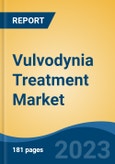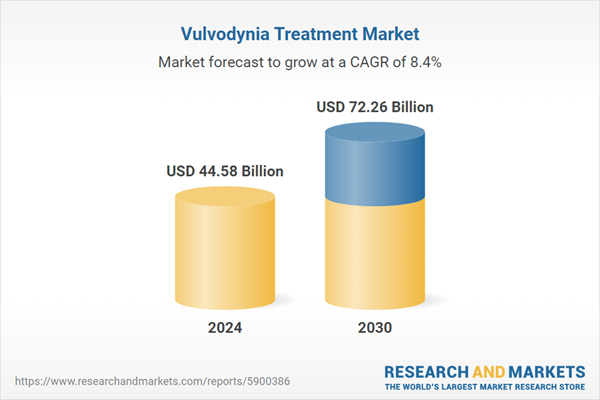Speak directly to the analyst to clarify any post sales queries you may have.
10% Free customizationThis report comes with 10% free customization, enabling you to add data that meets your specific business needs.
Treatment options are diverse, encompassing topical and oral medications, physical therapy, counseling, and surgical procedures in severe cases. The growing awareness of vulvodynia, improved diagnostic tools, and advances in therapeutic options are significantly driving the market. Increasing adoption of telemedicine and multidisciplinary care approaches - integrating gynecologists, physiotherapists, pain specialists, and mental health professionals - further supports market growth. Additionally, research into more effective and targeted therapies, supported by technological innovation, is expanding access to personalized care for vulvodynia patients globally.
Key Market Drivers
Technological Advancements
Technological innovations are playing a pivotal role in advancing the diagnosis and treatment of vulvodynia. High-resolution imaging tools such as MRI and ultrasound are increasingly used to assess pelvic anatomy and guide clinical decisions. The rise of telemedicine - particularly following the COVID-19 pandemic - has expanded access to specialist care for vulvodynia patients, especially those in remote areas. Additionally, artificial intelligence (AI) tools are being developed to assist in diagnosis by analyzing clinical data and identifying patterns indicative of vulvodynia.Other notable advancements include biofeedback and electrical stimulation devices used in pelvic floor therapy, targeted drug delivery systems (such as medicated topical creams), and mobile health apps for symptom tracking and patient education. Furthermore, wearable technologies and virtual reality interventions are emerging to help patients manage pain and monitor therapy effectiveness. These innovations are enhancing clinical outcomes and promoting a patient-centric approach to care, fueling the overall growth of the vulvodynia treatment market.
Key Market Challenges
Limited Treatment Options
A major challenge in the vulvodynia treatment market is the limited availability of effective, standardized therapies. Due to the condition’s complex and varied nature, patients often undergo a lengthy trial-and-error process to find relief. Treatment outcomes can vary widely among individuals, and medications such as anticonvulsants, antidepressants, or topical anesthetics may not deliver consistent or lasting results. Moreover, some of these drugs can cause adverse effects, complicating the treatment process.Access to non-pharmacological therapies like pelvic floor physical therapy and cognitive behavioral therapy is also inconsistent, particularly in rural or underserved regions. Compounding these issues is the lack of comprehensive understanding of the condition’s etiology, which hampers innovation in targeted drug development. Inadequate funding and limited awareness among healthcare providers further delay diagnosis and effective treatment. This shortage of robust treatment options often impacts patients’ mental well-being, underscoring the urgent need for broader access to specialized care and research-backed interventions.
Key Market Trends
Patient-Centered Care
The shift toward patient-centered care is becoming a key trend in the vulvodynia treatment market. Healthcare providers are increasingly emphasizing personalized treatment strategies that address not only the physical symptoms but also the psychological and emotional impact of chronic vulvar pain. This approach includes shared decision-making, where patients actively participate in choosing treatment plans tailored to their preferences and lifestyle.Education is also central to this model - patients are encouraged to understand their condition and engage in self-management techniques, such as lifestyle changes and therapy adherence. Multidisciplinary support - including physical therapy, pain management, and mental health services - is integrated to offer a holistic treatment pathway. Additionally, providers are more attuned to patient feedback and committed to respecting individual treatment choices, even when they involve complementary or alternative therapies. By focusing on empowering patients, this trend is improving satisfaction, adherence, and overall health outcomes in vulvodynia care.
Key Players Profiled in this Vulvodynia Treatment Market Report
- Novartis AG
- Endo International Inc
- Teva Pharmaceutical Industries Ltd
- Glenmark Pharmaceuticals Ltd
- Cipla Inc
- F. Hoffmann-La Roche Ltd
- Pfizer Inc
- Zydus Group
- Taro Pharmaceutical Industries Ltd
- Abbvie Inc.
Report Scope:
In this report, the Global Vulvodynia Treatment Market has been segmented into the following categories, in addition to the industry trends which have also been detailed below:Vulvodynia Treatment Market, by Type:
- Biofeedback & Physical Therapy
- Intralesional Injections
- Oral Treatment
- Surgical Treatment
- Topical Treatments
Vulvodynia Treatment Market, by Indication:
- Generalized Vulvodynia
- Localized Vulvodynia
Vulvodynia Treatment Market, by Providers:
- Hospitals & Care Providers
- Pharmaceutical & Biotechnology Companies
- Research & Development Centers
Vulvodynia Treatment Market, by Region:
- North America
- United States
- Canada
- Mexico
- Asia-Pacific
- China
- India
- South Korea
- Australia
- Japan
- Europe
- Germany
- France
- United Kingdom
- Spain
- Italy
- South America
- Brazil
- Argentina
- Colombia
- Middle East & Africa
- South Africa
- Saudi Arabia
- UAE
Competitive Landscape
Company Profiles: Detailed analysis of the major companies present in the Global Vulvodynia Treatment Market.Available Customizations:
With the given market data, the publisher offers customizations according to a company's specific needs. The following customization options are available for the report.Company Information
- Detailed analysis and profiling of additional market players (up to five).
This product will be delivered within 1-3 business days.
Table of Contents
Companies Mentioned
The leading companies profiled in this Vulvodynia Treatment market report include:- Novartis AG
- Endo International Inc
- Teva Pharmaceutical Industries Ltd
- Glenmark Pharmaceuticals Ltd
- Cipla Inc
- F. Hoffmann-La Roche Ltd
- Pfizer Inc
- Zydus Group
- Taro Pharmaceutical Industries Ltd
- Abbvie Inc.
Table Information
| Report Attribute | Details |
|---|---|
| No. of Pages | 180 |
| Published | May 2025 |
| Forecast Period | 2024 - 2030 |
| Estimated Market Value ( USD | $ 44.58 Billion |
| Forecasted Market Value ( USD | $ 72.26 Billion |
| Compound Annual Growth Rate | 8.3% |
| Regions Covered | Global |
| No. of Companies Mentioned | 11 |









